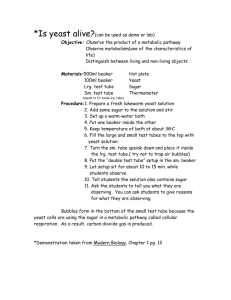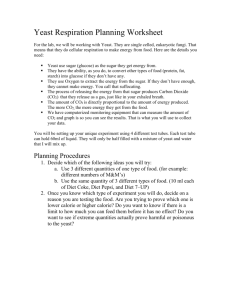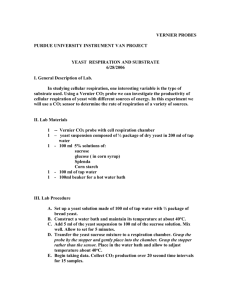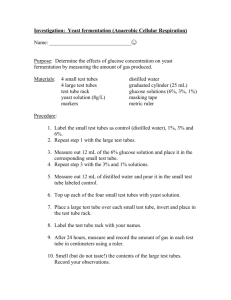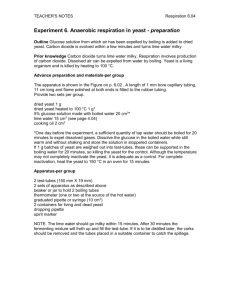Yeast Fermentation: Temperature Effect Lab Experiment
advertisement
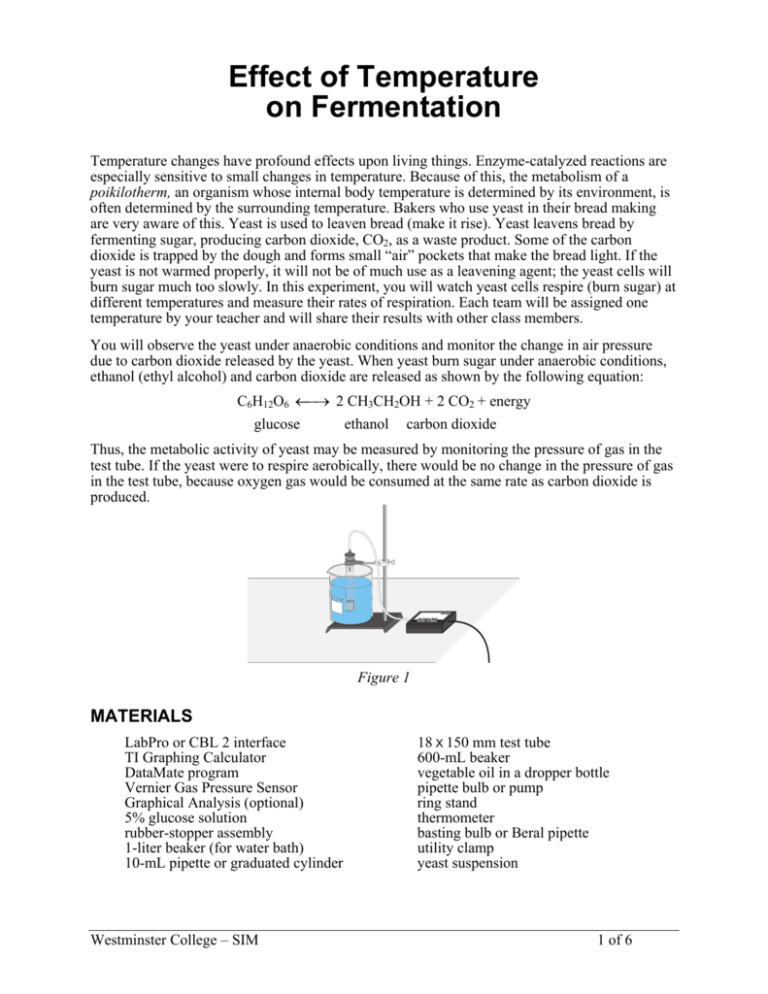
Effect of Temperature on Fermentation Temperature changes have profound effects upon living things. Enzyme-catalyzed reactions are especially sensitive to small changes in temperature. Because of this, the metabolism of a poikilotherm, an organism whose internal body temperature is determined by its environment, is often determined by the surrounding temperature. Bakers who use yeast in their bread making are very aware of this. Yeast is used to leaven bread (make it rise). Yeast leavens bread by fermenting sugar, producing carbon dioxide, CO2, as a waste product. Some of the carbon dioxide is trapped by the dough and forms small “air” pockets that make the bread light. If the yeast is not warmed properly, it will not be of much use as a leavening agent; the yeast cells will burn sugar much too slowly. In this experiment, you will watch yeast cells respire (burn sugar) at different temperatures and measure their rates of respiration. Each team will be assigned one temperature by your teacher and will share their results with other class members. You will observe the yeast under anaerobic conditions and monitor the change in air pressure due to carbon dioxide released by the yeast. When yeast burn sugar under anaerobic conditions, ethanol (ethyl alcohol) and carbon dioxide are released as shown by the following equation: ⎯→ 2 CH3CH2OH + 2 CO2 + energy C6H12O6 ← glucose ethanol carbon dioxide Thus, the metabolic activity of yeast may be measured by monitoring the pressure of gas in the test tube. If the yeast were to respire aerobically, there would be no change in the pressure of gas in the test tube, because oxygen gas would be consumed at the same rate as carbon dioxide is produced. 1 Figure 1 MATERIALS LabPro or CBL 2 interface TI Graphing Calculator DataMate program Vernier Gas Pressure Sensor Graphical Analysis (optional) 5% glucose solution rubber-stopper assembly 1-liter beaker (for water bath) 10-mL pipette or graduated cylinder Westminster College – SIM 18 X 150 mm test tube 600-mL beaker vegetable oil in a dropper bottle pipette bulb or pump ring stand thermometer basting bulb or Beral pipette utility clamp yeast suspension 1 of 6 PROCEDURE 1. Connect the plastic tubing to the valve on the Gas Pressure Sensor. If your sensor has a blue plastic valve on it, place the valve in the position shown in Figure 2. 2. Plug the Gas Pressure Sensor into Channel 1 of the LabPro or CBL 2 interface. Use the link cable to connect the TI Graphing Calculator to the interface. Firmly press in the cable ends. Connect tubing here Figure 2 3. Prepare a water bath for the yeast. A water bath is simply a large beaker of water at a certain temperature. This ensures that the yeast will remain at a constant and controlled temperature. To prepare the water bath, obtain some warm and cool water from your teacher. Combine the warm and cool water into the 1-liter beaker until it reaches the temperature you were assigned. The beaker should be filled with about 600 – 700 mL water. Place the thermometer in the water bath to monitor the temperature during the experiment. 4. Using a 10-mL pipette or graduated cylinder, transfer 2.5 mL of the glucose solution into a clean test tube. Label this test tube 1. 5. Gently swirl the yeast suspension to mix the yeast that settles to the bottom. Transfer 2.5 mL of yeast into test tube 1. Gently mix the yeast into the sugar solution. Be gentle with the yeast—they are living organisms! 6. In the test tube, place enough vegetable oil to completely cover the surface of the yeast/glucose mixture as shown in Figure 3. Be careful to not get oil on the inside wall of the test tube. Set the test tube in the water bath. 7. Insert the single-holed rubber-stopper into the test tube. Note: Firmly twist the stopper for an airtight fit. Secure the test tube with a utility clamp and ring-stand as shown in Figure 1. Vegetable oil Yeast/glucose 8. Incubate the test tube for 10 minutes in the water bath. Be sure to keep Figure 3 the temperature of the water bath constant. If you need to add more hot or cold water, first remove about as much water as you will be adding, or the beaker may overflow. Use a basting bulb to remove excess water. Note: Be sure that the test tube is completely covered by the water in the water bath. The temperature of the air in the tube must be constant for this experiment to work well. 9. While one team member is performing Step 8, another team member should prepare the calculator and interface for data collection. Turn on the calculator and start the DATAMATE program. Press CLEAR to reset the program. 10. Set up the calculator and interface for a Gas Pressure Sensor. a. If the calculator displays PRESS(KPA) in CH 1, proceed directly to Step 11. If it does not, continue with this step to set up your sensor manually. b. Select SETUP from the main screen. c. Press ENTER to select CH 1. d. Select PRESSURE from the SELECT SENSOR menu. e. Select the correct pressure sensor from the PRESSURE menu. f. Select the calibration listing for (KPA). g. Select OK to return to the main screen. Westminster College – SIM 2 of 6 11. When incubation has finished, connect the free-end of the plastic tubing to the connector in the rubber stopper as shown in Figure 4. 12. Select START to begin data collection. Maintain the temperature of the water bath during the course of the experiment. Record the average temperature of the water bath in Table 1. 13. Data collection will end after 15 minutes. Monitor the pressure readings displayed on the calculator screen. If the pressure exceeds 130 kilopascals, the pressure inside the tube will be too great and the rubber stopper is likely to pop off. Disconnect the plastic tubing from the Gas Pressure Sensor if the pressure exceeds 130 kilopascals. 14. When data collection has finished, an auto-scaled graph of pressure vs. time will be displayed on the calculator screen. As you move the cursor right or left, the time (X) and pressure (Y) values of each data point are displayed below the graph. Figure 4 15. Determine the rate of respiration for the curve of pressure vs. time. The rate of respiration can be measured by examining the slope of the pressure vs. time curve: a. Examine the graph and determine the most linear region. a. Move the flashing cursor to the first point of the region. Enter the initial pressure, Pi, and initial time, ti, in Table 1. a. Move the flashing cursor to the last point of the region. Enter the final pressure, Pf, and final time, tf, in Table 1. 16. Press ENTER , then select QUIT from the main screen to exit the DATAMATE program. DATA Table 1 Initial point Temperature Westminster College – SIM Pi (kPa) ti (s) Final point Pf (kPa) tf (s) Slope = Pf - P i t f - ti 3 of 6 Table 2: Class Data Group Temperature (°C) Rate of Respiration (kPa/s) 1 2 3 4 5 6 7 8 PROCESSING THE DATA 1. Calculate the slope of the pressure vs. time curve using the data in Table 1. The slope of the curve is equal to the rate of respiration. Record the calculated slope and temperature tested in Table 2. 2. Share your data with your classmates, by recording on the board, the temperature tested and the rate of respiration. 3. Record the data from the other groups in Table 2. 4. Using Graphical Analysis or by hand, create a graph of rate of respiration vs. temperature. The rate values should be plotted on the y-axis, and the temperature on the x-axis. QUESTIONS 1. On the basis of the results of this experiment, does temperature affect the rate of respiration of yeast? Explain. 2. Is there an optimal temperature for yeast respiration? How does this compare to the temperature yeast are at when “rising” while making bread? You may have to consult a cookbook to answer this. 3. Why does the fermentation rate decrease at very high temperatures? 4. It is sometimes said that the metabolism of poikilotherms doubles with every 10°C increase in temperature. Does your data support this statement? Explain. 5. What is the purpose of the oil on top of the water? 6. Do yeast always live in conditions where their consumption of energy is maximal? Explain. 7. Why do you need to incubate the yeast before you begin collecting data? 8. Yeast live in many different environments. Make a list of some locations where yeast might naturally grow. Estimate the temperatures of each of these locations and compare them to your results. Westminster College – SIM 4 of 6 TEACHER INFO Effect of Temperature on Fermentation 1. To prepare the yeast solution, dissolve 7 grams (1 package) of dried yeast per 100 mL of water. Incubate the suspension in 37 – 40°C water for at least 10 minutes. 2. Emphasize to your students the importance of providing an airtight fit with all plastic-tubing connections and when closing valves or twisting the stopper into a test tube. 3. All of the pressure valves, tubing, and connectors used in this experiment are included with Vernier Gas Pressure Sensors shipped after February 15, 1998. These accessories are also helpful when performing respiration/fermentation experiments such as Experiments 11C, 12B, and 16B in this manual. If you purchased your Gas Pressure Sensor at an earlier date, Vernier has a Pressure Sensor Accessories Kit (PS-ACC, $7) that includes all of the parts shown here for doing pressurerelated experiments. Using this kit allows for easy assembly of a completely airtight system. The kit includes the following parts: • • • • • • two ribbed, tapered valve connectors inserted into a No. 5 rubber stopper one ribbed, tapered valve connectors inserted into a No. 1 rubber stopper two Luer-lock connectors connected to either end of a piece of plastic tubing one two-way valve one 20-mL syringe two tubing clamps for transpiration experiments 4. The accessory items used in this experiment are the #1 single hole stopper fitted with a tapered valve connector and the section of plastic tubing fitted with Luer-lock connectors. 5. The length of plastic tubing connecting the rubber stopper assemblies to each Gas Pressure Sensor must be the same for all groups. It is best to keep the length of tubing reasonably small to keep the volume of gas in the respirometer low. Note: If pressure changes during data collection are too small, you may need to decrease the total gas volume in the system. Shortening the length of tubing used will help to decrease the volume. 6. To prepare the 5% glucose sugar solution, add 5 grams glucose per 100 mL of solution. Sucrose may be substituted for glucose, if desired. 7. Temperatures of 10, 20, 30, 40, 50, and 60°C are suggested. Assign one temperature to each student team. 8. Turkey basters make excellent tools for removing water from the water bath as the temperature of the water bath is being maintained. Beral pipettes also work well. 9. Students can practice maintaining the water bath temperature during the incubation period. 10. If time permits, you may wish to extend the experiment length from 15 minutes to 30 minutes. Westminster College – SIM 5 of 6 SAMPLE RESULTS The following data may be different from students’ results. The actual values depend upon the viability and age of the yeast, among other factors. Class Data Temperature (°C) Rate of Fermentation 10 8.5 x 10-4 20 1.2 x 10-3 30 6.6 x 10-3 40 1.3 x 10-2 50 8.7 x 10-3 60 8.3 x 10-5 ANSWERS TO QUESTIONS 1. Yes, temperature does affect the rate of fermentation in yeast. The rate should increase from 10°C to 40°C. At 50°C and above, the rates will decrease. 2. The temperature yielding the highest rate of fermentation should be in the 40°C range. 3. The fermentation rate at high temperatures will be low because high temperatures are lethal to yeast. Enzymes move too fast and denature at high temperatures. 4. Results may vary. 5. The oil prevents oxygen from the air in the test tube from entering the solution. This helps keep the yeast anaerobic. It also helps keep the water from evaporating. 6. No, yeast do not always live in conditions where their consumption of energy is maximal. Higher temperature conditions may not really be optimal under all conditions. Overpopulation, competition for resources such as food, and waste production may accompany maximal energy consumption. Also, the majority of habitats available to yeast are not at this temperature, so their distribution is much greater. 7. The yeast need to be incubated so that the oxygen in the test tube will be completely consumed. If the yeast respire aerobically, no pressure change occurs, because much oxygen is consumed as CO2 is produced. It also takes a few minutes for the yeast to transport the sugar into the cell, to respire at a constant rate, and to reach the proper temperature. 8. Lists may vary. Some yeast live on other organisms. If the other organisms are warm blooded, they may be near the optimal temperature for yeast respiration, 37°C. Many yeast live in soils. The temperature of soils may easily be measured at different times of the year. Westminster College – SIM 6 of 6

